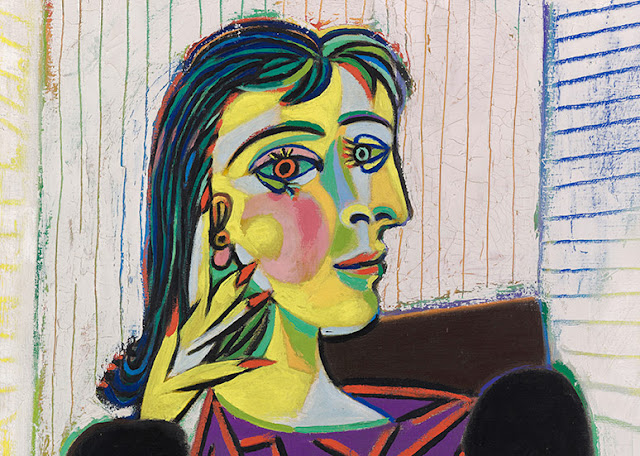Pablo Picasso. Portrait of Dora Maar. Paris, 1937. Oil on canvas, 92 x 65 cm (without frame). MP158 © Sucesión Pablo Picasso, VEGAP, Madrid 2019
A SUBLIME FRIENDSHIP
From 8.11.2019 to 15.3.2020
Museu Picasso | Picasso Museum
Carrer Montcada, 15-23, Barcelona, Catalunya
Metro: L4 - Jaume I Station (yellow) or L3 - Liceu Station (green)
Paul Eluard was Picasso’s best friend from 1935 onwards. Following the disappearance of Apollinaire, Eluard was the only poet with who Picasso could converse and exchange or share ideas. Quickly, the surrealist poet became literally captivated by the demiurge-artist, “who insists of seeing everything, on projecting onto the screen of man everything he can understand, admit or transform, figure and transfigure... With Picasso, the walls come down”. Only Eluard’s death, on 18 November 1952, would put an end to this brotherhood.
Henriette Theodora Markovitch (Tours, 22nd November 1907—Paris, 16th July 1997), known as Dora Maar, was a surrealist photographer, ideologically close to the far left. She met Picasso in 1936, through the mediation of Paul Eluard, and would soon become his companion and model, and influence in the politicization of the artist. At the outbreak of the Spanish Civil War, Eluard, Maar and Picasso took the side of the legitimate government and republican cause. Moved by the bombings of Franco's army over Madrid, Eluard wrote his first manifestly political poem, «November 1936», which would be published in L’Humanité on 17th December of the same year. The text inspired Picasso to produce the prints of the Dream and Lie of Franco, in January 1937. In 1938, «November 1936» would be published once again in the form of a book entitled Solidarité, accompanied by etchings by various artists.
The outbreak of the war would separate Eluard, mobilized, from Picasso, who would alternate his residence in Paris with stays in Royan. They would see each other again in the French capital at the end of August 1940. During this period they would frequently meet up with other friends, such as Michel and Louise Leiris, Apel·les Fenosa, Óscar Domínguez and Robert Desnos, in the restaurant Le Catalan, situated in front of Picasso’s studio in the rue des Grands-Augustins.
In 1942, Eluard joined the French Communist Party once again and had to go underground, which meant that he frequently had to be absent from Paris. However, he and Picasso remained in touch and met up in Picasso’s studio, in Le Catalan, or in the home of Christian and Ivonne Zervos.
Picasso and Eluard collaborated with the movements and congresses for peace and the elaboration of the book Le Visage de la paix. The doves of Picasso were used for the congress posters and became a symbol for peace. In 1948, both of them attended the World Congress of Intellectuals for Peace in Wroclaw (Breslau, Poland), where Picasso gave a brief speech. During this trip they visited Auschwitz.
Eluard died on 18th November 1952 from a heart attack. Picasso, accompanied by friends and comrades from the Communist Party, watched over the body of the poet and drew a dove, with the inscription «pour mon cher Paul Eluard».
On November 22 he was buried in the Père-Lachaise cemetery, in division 97, inside the area for communists and far away from Nusch. When the government opposed the national funeral and the passing of the funeral procession through the streets of Paris, a multitude of friends, comrades and anonymous people gathered at the cemetery doors to pay their last tribute to the author of «Liberté». The funeral speeches were given by Vercors (Jean Bruller), Louis Aragon, Laurent Casanova, André Delacour and Jean-Charles Gateau.
Picasso, visibly moved, attended the funeral accompanied by Cécile Eluard and Elsa Triolet, to pay his last respects to his great friend.
Paul Eluard was Picasso’s best friend from 1935 onwards. Following the disappearance of Apollinaire, Eluard was the only poet with who Picasso could converse and exchange or share ideas. Quickly, the surrealist poet became literally captivated by the demiurge-artist, “who insists of seeing everything, on projecting onto the screen of man everything he can understand, admit or transform, figure and transfigure... With Picasso, the walls come down”. Only Eluard’s death, on 18 November 1952, would put an end to this brotherhood.
In 1942, Eluard joined the French Communist Party once again and had to go underground, which meant that he frequently had to be absent from Paris. However, he and Picasso remained in touch and met up in Picasso’s studio, in Le Catalan, or in the home of Christian and Ivonne Zervos.
On 4th October 1944, after the liberation of Paris, Picasso joined the French Communist Party, in an event attended by Paul Eluard and Louis Aragon. On the next day, his joining was announced in L’Humanité, in a report illustrated with three photographs, a drawing of The man of the lamb, and a text by Eluard.
Picasso and Eluard collaborated with the movements and congresses for peace and the elaboration of the book Le Visage de la paix. The doves of Picasso were used for the congress posters and became a symbol for peace. In 1948, both of them attended the World Congress of Intellectuals for Peace in Wroclaw (Breslau, Poland), where Picasso gave a brief speech. During this trip they visited Auschwitz.
On November 22 he was buried in the Père-Lachaise cemetery, in division 97, inside the area for communists and far away from Nusch. When the government opposed the national funeral and the passing of the funeral procession through the streets of Paris, a multitude of friends, comrades and anonymous people gathered at the cemetery doors to pay their last tribute to the author of «Liberté». The funeral speeches were given by Vercors (Jean Bruller), Louis Aragon, Laurent Casanova, André Delacour and Jean-Charles Gateau.
Picasso, visibly moved, attended the funeral accompanied by Cécile Eluard and Elsa Triolet, to pay his last respects to his great friend.
.
